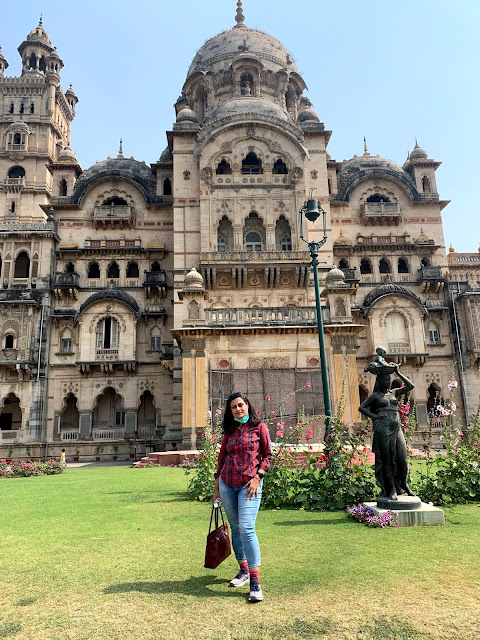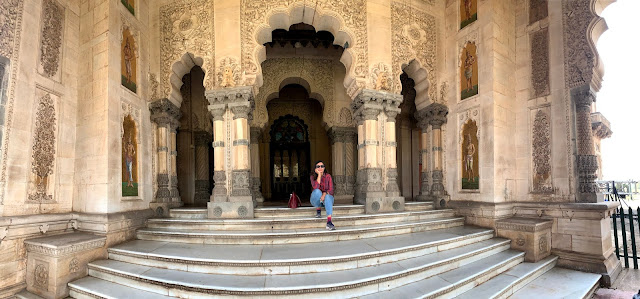The city that is believed to have been named after The Banyan Tree holds rich Art, Architecture, History and Culture in its cupped and caring hands. Vat-Vriksha, the Banyan Tree gave the name to the city and it came to be known as Baroda or Vadodara. The third-largest city in the state of Gujarat, perched on the banks of River Vishwamitri, is a very important economic hub with many large-scale industries having sprouted and flourished here.
I take you on a “just-a-day” tour of this magnificent city. Though Vadodara can not be capsuled in just one day, I club the highlights together for those who are short on time.
First, the architecture, history and art because all of this comes together in Vadodara as an all-in-one package!
The Mesmerising Laxmi Vilas Palace
Start your day with a hearty breakfast and head straight to the Laxmi Vilas Palace. Rows of flowers- lilac-pink-orange, greens of the golf course and splendour of the Majestic Palace welcome the wide-eyed curious traveller in you. A short driveway later, the ticket counter would fall to your left. The ticket fee includes an audio guide service and you may choose the language that you are most comfortable in. The audio guide is thorough and detailed and easy to comprehend and goes at a slow pace allowing you ample time to savour the sights that delight your visual senses.
The tour begins at the rear garden of the Palace, the vast expanses and the life-size statues that adorn this beautifully manicured Italian garden with its pretty water fountains are sure to hold your gaze for long. But just as you turn around to have a look at the palace, your jaw would drop with a gasp! The Palace is a magnificent Indo-Saracenic wonder which is the largest private home to be built in those times, an astounding four times the size of the Buckingham Palace. The fine architecture against the azure skies is a picture postcard that you would soon walk into.
I am not giving details of the artefacts on display because 1. There are way too many for anyone to remember and 2. It kills the anticipation of visiting a museum. Click away to your heart’s content and just follow the location numbers that your audio guide takes you through. Once inside, you would be taken through chambers upon chambers filled with artefacts, weapons, paintings and portraits from the private collection of the erstwhile Maratha rulers of Vadodara, who still reside in a section of the Palace. There are paintings galore, weaponry section stashed with the finest of the swords and shields of the time, statues so lifelike that they might just wink at you and make you turn around for a second look and chandeliers so exquisite that you might get dizzy looking up marvelling at them! While the insides of the museum give you a glimpse of the opulence, eminence and glory of the Gaekwads of Baroda, the outdoors would keep you enthralled with piece after piece de resistance! The statues of beasts and wildlife placed all over the gardens and the Golf Course make for a very interesting around-the-palace tour.
This is where the King’s throne was, this is where the Royalty assembled, here the musicians enthralled their audience and that’s where the dancers pirouetted, portraits of the British teachers who taught the young princes and princesses also adorn the walls of this hall that has seen many distinguished gatherings, we are inside the magnificent Durbar Hall. Adorned with Belgian stained glass windows that depict beautiful paintings, with a large Royal Regalia on the tiled floor, and busts of the various Maharajas who ruled over Vadodara displayed along the walls, this hall has witnessed many events and cultural shows where eminent musicians and artists performed.
As I said, the Palace is sure to hold you in awe. The audio guide tour will now guide you toward to facade again and this is where a masterpiece awaits your attention. This is a Venetian Ceramic Mosaic that is said to depict the joyous embrace of Lord Ram and Devi Sita after she emerged from the Agnipariksha. This work of art took 18 months to be meticulously and painstakingly put together.
The tour of the Laxmi Vilas Palace ends here and one must return the audio guide back to the office where it was received from.
Rendezvous with Raja Ravi Varma at Maharaja Fateh Singh Museum
After having an all-engaging and fascinating tour of The Laxmi Niwas Palace museum, I was sure nothing else can now hold me in awe anymore; might hold my attention for a while, yes, but not leave me bewitched for sure. But oh, I was wrong, so wrong; for The Maharaja Fateh Singh Museum can keep an art aficionado for hours in there with so many chambers filled with so many originals, be it the sculptures or the paintings. I feel this museum requires repeat visits to properly soak in all the treasure that it showcases.
This is where my eyes met an original Raja Ravi Varma for the first time. And painting after painting I kept stepping back to the times when these paintings were commissioned at the behest of Maharaja Sir Sayajirao Gaekwad III of Vadodara. There are the originals from Indian Mythology for which Raja Ravi Varma was known and then there are so many portraits of members of the Royal Family. The intricacy and detail in each painting is beyond anything that you might have seen elsewhere.
 |
| Nal-Damyanti by Raja Ravi Varma, image sourced from Internet |
This building was constructed as a school for the Maharaja’s children and had a tiny toy train too, which in its time ran on its specially fixed rails all across the vast compound that surrounds the museum building. The World’s smallest locomotive engine of this train can be seen just near the main entrance of the museum, carefully parked in a glass enclosure.
 |
| The Maharaja Fateh Singh Museum. Image source: Incredible India |
This museum is a paradise for art connoisseurs. There are more than 30 original works of Raja Ravi Verma, besides other breathtaking paintings by other renowned artists. A treasure trove of marble and bronze statues, busts and exquisite vases grace the two floors here. Another artist whose remarkable work is displayed in abundance is the Italian artist Fellicci, who too was commissioned by the Maharaja for creating various art pieces that can now be seen in this museum. An Oriental gallery showcases ornate vases, exclusive toys and other artefacts from China and Japan. Photography is prohibited inside the museum complex.
All this intense museum hopping is sure to make one hungry, and a Gujarati thali would just be the saviour.
Coming together of Art and Architecture in a garden - The Sayaji Bagh
A one day trip to Baroda has to be centred around the art and architecture of this beautiful city. Post lunch, I recommend you visit The Vadodara Museum and Picture Gallery which is located within the 100 acres of the largest garden of western India - Sayaji Bagh! This architectural marvel is designed on the lines of London’s Science Museum and the Victoria and Albert Museum. Reflection of Maharaja’s penchant for all things art can be seen here as well with artefacts related to Geology, Archaeology and Natural History displayed in the various halls, besides many other pieces of art from the personal collection of the Maharaja himself.
The evening can then be spent in the magnificent garden which houses more than 98 species of trees and also has a majestic floral clock.
 |
| The Floral Clock at Sayaji Bagh. Image source: VMC |
A day well spent and leaving you longing for more - that’s an ideal day in Vadodara. Do not forget to pick up some lip-smacking farsaans and Gujarati snacks from here for munching on later and reminiscing your Baroda trip. I would ideally love to end a day like that with some Sev Usal and loads of Aamras!






